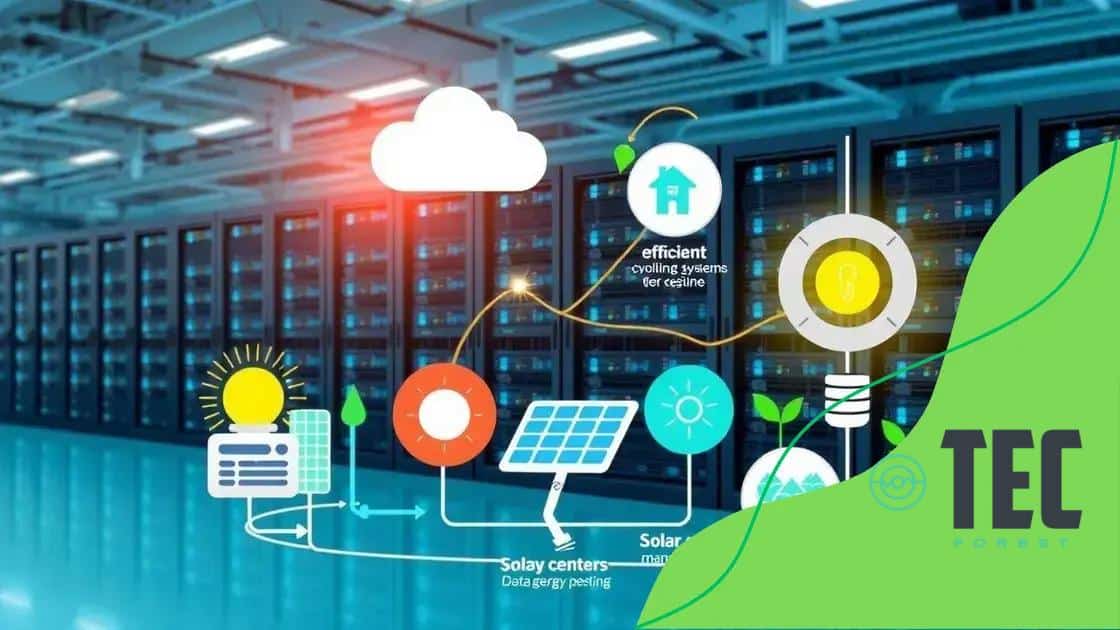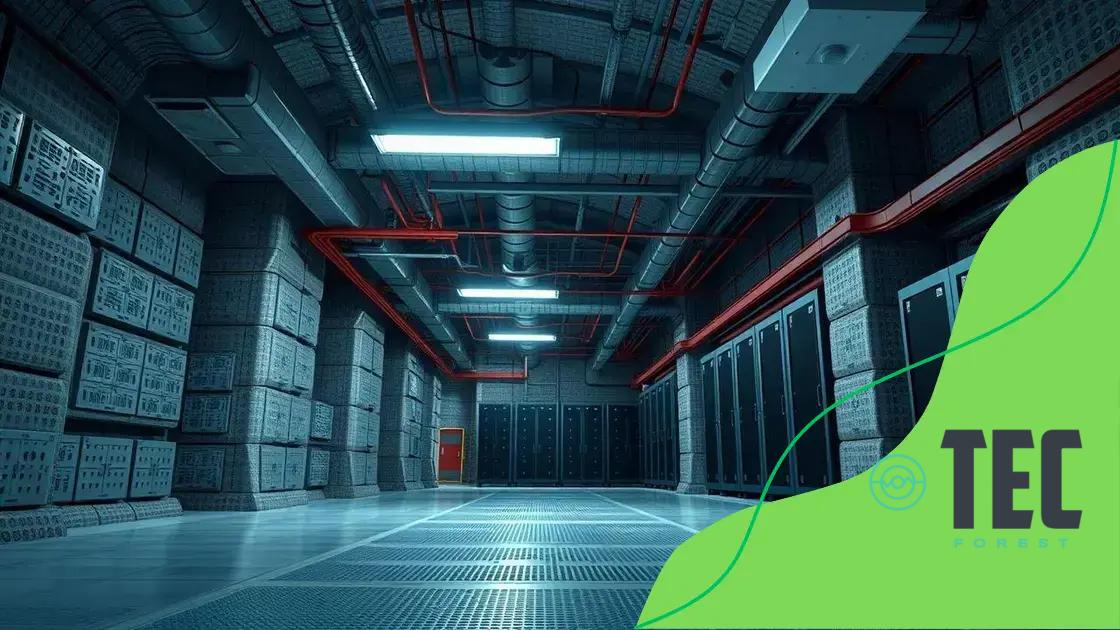Advertisement
Underground data centers are innovative facilities that leverage the earth’s natural cooling for energy efficiency, providing significant cost savings and environmental benefits while facing unique challenges like construction costs and environmental risks.
Underground data centers touted for energy efficiency are reshaping how we think about data storage. Have you considered how these innovative spaces can decrease environmental impact? Let’s dive into their potential.
Advertisement
What are underground data centers?
Underground data centers are fascinating facilities designed to house computer systems and associated components in subterranean environments. These innovative spaces provide a unique solution for companies looking to enhance their data storage capabilities while reducing their environmental impact. With increasing energy demands, understanding what underground data centers are is crucial for businesses aiming for sustainability.
Key Features of Underground Data Centers
One of the most significant aspects of these data centers is their ability to maintain optimal temperature and humidity levels naturally. Being underground provides insulation from external temperature fluctuations, thus requiring less energy for cooling. Additionally, these centers often make use of renewable energy sources, further minimizing their carbon footprint.
Advertisement
- Natural cooling due to underground location.
- Energy-efficient with potential renewable energy use.
- Enhanced security from physical threats.
- Lower land and construction costs compared to above-ground facilities.
Underground data centers also offer increased physical security. Their locations make them less accessible to potential breaches and natural disasters, such as floods and hurricanes. These factors contribute significantly to their appeal for businesses that handle sensitive information.
Moreover, these facilities can operate with a smaller environmental footprint. The exploration of subterranean spaces allows for innovative designs that challenge traditional data center models. Companies can benefit from reduced energy costs and improved sustainability practices.
Case Studies and Implementations
Several companies have successfully implemented underground data centers, showcasing their viability. For instance, one tech giant built a facility deep underground to harness the natural coolness of the earth, which significantly lowered their energy consumption. This model has set a precedent, influencing other organizations to consider similar solutions.
As the demand for data continues to grow, understanding the role of underground data centers in the overall infrastructure becomes even more vital. They represent the intersection of technology and sustainability, paving the way for greener data management practices in the future.
Advantages of energy efficiency in data centers

Energy efficiency in data centers is essential for reducing operational costs and minimizing environmental impact. Understanding the advantages of energy efficiency in data centers can help businesses make informed decisions about their infrastructure. As energy demands rise, it’s crucial to explore why these efficiencies matter.
Cost Savings
One of the most significant benefits of energy efficiency is the reduction in energy bills. By utilizing energy-saving technologies, data centers can lower their operational costs significantly. Organizations can allocate these savings to other critical areas, enhancing overall productivity.
- Lower electricity costs through optimized equipment.
- Increased lifespan of equipment, reducing replacement frequency.
- Tax incentives for energy-efficient upgrades.
- Improved return on investment (ROI) over time.
In addition to financial savings, energy efficiency contributes to sustainability. By decreasing energy consumption, data centers can reduce their carbon footprint. This aligns with global initiatives aimed at combating climate change, appealing to environmentally conscious consumers.
Enhanced Reliability
Another advantage is improved reliability. Energy-efficient data centers are often designed with redundancies in place, ensuring continuous operation. This reliability minimizes downtime, a critical concern for businesses relying on data availability.
Advanced cooling techniques, such as free air cooling, can maintain optimal temperatures without excessive energy use. By investing in energy-efficient systems, organizations can ensure that their data centers remain operational during peak demands.
Aside from performance and sustainability, energy efficiency also enhances security. With reduced energy consumption comes less heat production, leading to lower risks of overheating and system failures. This aspect is crucial for maintaining the integrity of data storage.
Attracting Business Opportunities
Organizations that prioritize energy efficiency can attract new clients who value sustainability. By showcasing green initiatives, data centers can differentiate themselves in a competitive market. Many businesses are now required to meet specific environmental standards, and having energy-efficient operations can give them a competitive edge.
Ultimately, the advantages of energy efficiency in data centers extend beyond immediate financial returns. They contribute to long-term sustainability, reliability, and business growth, making them an essential consideration for modern enterprises.
How underground locations reduce energy costs
Underground locations play a crucial role in reducing energy costs for data centers. By harnessing the natural properties of the earth, these facilities can maintain optimal environmental conditions with minimal energy input. Understanding how underground locations reduce energy costs can provide insight into the future of data management.
Natural Cooling Benefits
One of the most significant advantages of being underground is the ability to utilize the earth’s stable temperature for cooling. Unlike above-ground facilities, which require substantial energy for cooling systems, underground data centers benefit from the coolness of the surrounding soil. This helps in significantly lowering the energy needed for air conditioning.
- Stable ground temperatures reduce cooling demands.
- Lower reliance on energy-intensive cooling systems.
- Utilization of geothermal energy for additional efficiency.
- Minimized operational costs leading to increased profitability.
Moreover, the reduced need for mechanical cooling means that these facilities can operate with smaller carbon footprints. As energy prices continue to rise, taking advantage of natural cooling will provide a competitive edge to organizations investing in these solutions.
Insulation and Protection
Being located underground also provides natural insulation. This insulation not only helps maintain temperature but also protects against external environmental factors. These include extreme weather conditions and temperature fluctuations that affect above-ground facilities. As a result, underground data centers can achieve higher energy efficiency.
This insulation leads to a more consistent internal environment, reducing the wear and tear on equipment. Consequently, organizations can expect a longer lifespan for their servers and machines, further lowering long-term energy costs.
Renewable Energy Integration
Additionally, many underground data centers have the opportunity to integrate renewable energy sources. Solar panels, when placed on the surface, can provide a sustainable power source for operations. This integration significantly reduces ongoing energy costs and establishes a more environmentally friendly operation.
By combining natural advantages with sustainable practices, underground data centers become a model for future energy-efficient facilities. They not only save money but also set an example for how businesses can invest in greener technologies.
Challenges faced by underground data centers

While underground data centers offer many advantages, they also face several unique challenges. Understanding these challenges faced by underground data centers is crucial for businesses considering this innovative approach. Each obstacle can impact the design, operation, and cost-effectiveness of these facilities.
Initial Construction Costs
Building an underground data center often requires higher initial investment compared to traditional above-ground facilities. Excavation and specialized construction techniques increase up-front expenses. Companies must weigh these costs against potential long-term savings on energy and maintenance.
- Excavation and foundation work can be costly.
- Specialized materials may be needed for durability.
- Access roads and infrastructure can add to expenses.
- Engineering challenges require expert consultation.
As a result, some companies may hesitate to invest, particularly if they are unsure about the return on investment.
Environmental Risks
Another challenge involves environmental risks, such as flooding and groundwater contamination. Underground locations are vulnerable to natural disasters that may not affect above-ground facilities. Systems must be in place to monitor and manage these risks to ensure operational safety.
Regular assessments of groundwater levels and water management systems are essential. Additionally, integrating fail-safes and alarm systems can help mitigate potential disasters.
Ventilation and Air Quality Control
Underground data centers need proper ventilation to manage airflow and maintain air quality. Efficient cooling and humidity control systems must be designed to work effectively in confined spaces. This can be difficult since ventilation systems must operate without losing energy efficiency.
Inadequate air circulation can lead to overheating, affecting equipment performance. Consequently, investing in advanced climate control technologies is essential for keeping equipment running smoothly.
Security Concerns
Security is another challenge. Although underground locations often offer natural protection from external attacks, they can also be isolated. In case of emergencies, quick access to facilities might be hindered, making it crucial to implement robust security measures.
In addition to physical security, cybersecurity is vital. With many systems operating underground, ensuring that data remains secure and protected from cyber threats should be a top priority.
Future trends in energy-efficient data centers
The future of energy-efficient data centers is bright and filled with innovation. As technology advances, understanding the future trends in energy-efficient data centers helps organizations stay ahead of the competition. Companies are constantly looking for ways to save costs and reduce their environmental impact.
Increased Use of AI and Automation
Artificial intelligence (AI) and automation are set to play crucial roles in future data centers. These technologies can optimize energy usage by predicting and adjusting cooling and power demands in real time. By analyzing data patterns, AI can help reduce unnecessary energy consumption, leading to more efficient operations.
- Automated systems for power management.
- AI algorithms for predictive maintenance.
- Real-time adjustments based on data analysis.
- Improved overall efficiency and reduced downtime.
As businesses become more reliant on data, these advancements will prove essential for maintaining efficient data center operations.
Integration of Renewable Energy Sources
Another significant trend is the increased focus on integrating renewable energy sources into data center operations. Many companies are looking to power their facilities with solar, wind, or geothermal energy. By investing in renewable energy, businesses can reduce their reliance on fossil fuels, leading to a smaller carbon footprint.
Some businesses are developing partnerships with local energy providers to create energy projects. Moreover, energy storage systems, like batteries, are becoming more common, allowing data centers to store excess energy generated during peak production times.
Enhanced Cooling Technologies
Innovative cooling technologies are also emerging as a major trend in energy-efficient data centers. New methods such as liquid cooling and free air cooling are gaining popularity. These techniques provide better heat management than traditional air conditioning systems.
Liquid cooling systems, for example, can transfer heat away from servers more efficiently, reducing energy use. As these technologies evolve, they will help lower operational costs and improve overall performance.
Focus on Sustainability and Green Certifications
Finally, the emphasis on sustainability will continue to shape the future of energy-efficient data centers. More organizations are seeking green certifications such as LEED (Leadership in Energy and Environmental Design) to demonstrate their commitment to environmental responsibility.
These certifications require meeting specific energy efficiency standards, which help businesses attract eco-conscious customers. By prioritizing sustainable practices, companies position themselves as leaders in the industry.
FAQ – Frequently Asked Questions about Underground Data Centers
What are underground data centers?
Underground data centers are facilities located below ground that utilize the earth’s natural temperature for cooling and energy efficiency.
How do underground locations reduce energy costs?
They take advantage of stable soil temperatures for cooling, minimizing the need for energy-intensive air conditioning and cooling systems.
What challenges do underground data centers face?
Challenges include higher construction costs, environmental risks like flooding, and the need for advanced cooling and ventilation systems.
What future trends can we expect in energy-efficient data centers?
Expect increased use of AI, integration of renewable energy sources, and advanced cooling technologies to enhance efficiency and sustainability.
